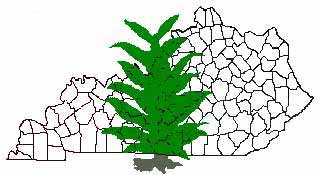

Blue mold has not been reported from Kentucky or adjacent states, but is active in the prevailing wind routes to the regions - on cultivated tobacco in the southeastern USA and on wild tobacco in the southwestern USA and Mexico. Plant Pathologists in Florida and Georgia report that blue mold is active in plant beds in northern Florida and southern Georgia. Plants from some of these diseased beds are being transplanted. Blue mold probably has been present at low levels for about a month and may have exposed crops from northern Florida to the Carolinas. Moreover, some seedling plants may have been moving into Kentucky from, or traveling through, this region of the USA during the past few weeks and other movements may be planned for the future.
We have reviewed the weather events of the past month and see no events that would have likely moved viable spores from that region to the Ohio River Valley. Moreover, our diagnostic labs and county offices report that very few calls have been received concerning tobacco transplant diseases. In part, this may be due to the high number of cool days with bright sunlight experienced, requiring more heating. Disease potential under those conditions are minimal due to dry foliage and natural chemicals in the tobacco leaves. However, a few days of warm, cloudy weather with increasing plant canopy could rapidly shift the situation from low disease potential to high! Thus, take steps to reduce leaf moisture through careful management of ventilation and keep in place a regular fungicide spray program. See issue 943 of Kentucky Pest News (March 18, 2002) for more specifics on chemical options for disease control in tobacco transplant production.
For the latest blue mold status and other tobacco disease information, check the KY Blue Mold Warning System.
![]() http://www.uky.edu/Agriculture/kpn/kyblue/kyblue.htm
http://www.uky.edu/Agriculture/kpn/kyblue/kyblue.htm

Extended periods of cool, wet weather last month were ideal for development of Sclerotinia crown and stem rot, a disease that can cause serious stand loss in both alfalfa and red clover. In alfalfa, typically one only finds damaging outbreaks in crops seeded the previous autumn. In red clover, research in Ohio suggests that the crop is susceptible throughout its life.
Infections from Sclerotinia begun last year, during the period from mid-October through mid-December. Stand loss can occur at that time, if infections progress to the crowns of infected plants. Sometimes, however, serious stand loss does not occur until weather conditions develop like we had during all the wet weather last month. In these cases, the plants were already infected last year, but they remained alive and may have even looked relatively healthy. With the onset of extended cool, wet weather, infections progressed to the point where plants were killed. Furthermore, the wet weather was favorable for the spread of infection from plant to plant, since fungal mycelium (cottony infectious threads) could develop and grow from one plant to the next. Affected shoots would show wilting and quickly progress from green to yellow to a tan color associated with tissue death. During the wet weather, a careful observer might see the white cottony mycelium at the crown of diseased plants. More commonly, one simply sees the sclerotia on dead plants or on the soil very near the dead crowns. Sclerotia are the survival bodies of Sclerotinia trifoliorum produced on or near dead plants. They are black, oval to irregular in shape, and measure about 1/16" to 3/16" in size. If the plants are rotted away, the sclerotia may be on the soil surface, or they may be buried to a depth of up to 3/8". Sclerotia are sometimes produced to a depth of 3/8", but they also can become buried by beating rain once they are dislodged from a rotting plant. Be sure to cut open the sclerotia and look for a gray to white color. Manganese concretions can be somewhat similar to sclerotia in overall appearance, but these are brown to black inside and are quite hard.
Alfalfa plants that were small going into dormancy last fall may be rotted away by now, and there may be no evidence whatsoever that there were young alfalfa plants there last fall. Furthermore, small plants sometimes produce very small sclerotia (1/16"). It can be difficult to find these very small sclerotia somewhere in the top 3/8" of soil in these situations.
If the disease has been active recently, there is no rescue treatment available to producers. If essentially all of the seeding has been completely killed by the disease, it is often safe to reseed. Once the fungus has produced sclerotia, it is going into dormancy for the summer, so a new seeding is not usually at risk.
If plants were wilting and dying as recently as the last couple of weeks, and other live plants remain in the field, it is risky to reseed a forage legume at this time, because, the fungus will resume activity and attack the seedlings when weather permits. In these cases, one can wait to reseed a forage legume until May 15, after which weather is typically too warm for the fungus. However, there is an increasing risk of drought damage to seedings made that late. Usually the best approach for fields where the disease still may resume activity is to seed with a non-legume forage crop. For seeding made before April 15-20, cool-season grasses are an option; seedlings past May 1 should be sown to summer annuals.
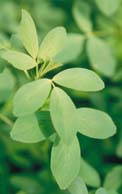
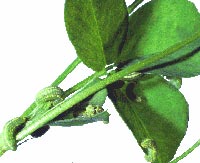 Late last week alfalfa weevil larvae in 4 Fayette county
fields ranged from 1/8 to 1/4 inch long. They were
deep within the foliage tips and it took careful
examination to find them or to see the small feeding
holes. As the larvae get larger and feed more,
moderately to heavily infested fields can take on a
gray or frosted appearance. This can be seen now in
some south central counties.
Late last week alfalfa weevil larvae in 4 Fayette county
fields ranged from 1/8 to 1/4 inch long. They were
deep within the foliage tips and it took careful
examination to find them or to see the small feeding
holes. As the larvae get larger and feed more,
moderately to heavily infested fields can take on a
gray or frosted appearance. This can be seen now in
some south central counties.
The best management decisions are based upon stem sampling (See Insecticide Recommendations for Alfalfa linked below). If this information is not available, then control is recommended when 25% to 50% of the tips show feeding injury and there are 3 or more larvae per stem.
 Pea aphids will be building up on alfalfa tips during
the next few weeks. They are favored by cool weather
and will disappear as conditions get hotter and drier.
These aphids are rarely abundant enough to cause any
type of yield or quality loss and control should be
considered only if there is significant wilt due to sap
removal.
Pea aphids will be building up on alfalfa tips during
the next few weeks. They are favored by cool weather
and will disappear as conditions get hotter and drier.
These aphids are rarely abundant enough to cause any
type of yield or quality loss and control should be
considered only if there is significant wilt due to sap
removal.
See Insect Recommendations for more alfalfa pest recommendations.
 As grape buds begin to swell, grape flea beetle is one
insect that grape producers need to be on the lookout
for. Adults eat buds and unfolding leaves, causing
leaves to be ragged and tattered. It is this early feeding
on small buds that can cause loss in yields. Later in
the spring, larvae feed on flower clusters and
skeletonize leaves, but that damage is less injurious to
yield.
As grape buds begin to swell, grape flea beetle is one
insect that grape producers need to be on the lookout
for. Adults eat buds and unfolding leaves, causing
leaves to be ragged and tattered. It is this early feeding
on small buds that can cause loss in yields. Later in
the spring, larvae feed on flower clusters and
skeletonize leaves, but that damage is less injurious to
yield.
 Adults are dark metallic greenish-blue, jumping
beetles about 1/5 inch long; larvae are brownish and
marked with black spots; eggs are pale yellow, and
fairly conspicuous on upper leaf surface or under
loose cane bark. Adults overwinter in protected areas
around vineyards, and start feeding on the interior of
primary buds and opening grape leaves in early
spring. Damage is often restricted to vineyard
borders, particularly near wooded areas. Damaged
buds are often hollowed out and may not develop into
primary canes which can reduce yields. Once the buds
are 1/2 inch long, only slight injury is caused.
Scheduled sprays for grape berry moth and
leafhoppers provide effective control. Where flea
beetles have been a problem, a spray timed at bud
swell can provide control.
Adults are dark metallic greenish-blue, jumping
beetles about 1/5 inch long; larvae are brownish and
marked with black spots; eggs are pale yellow, and
fairly conspicuous on upper leaf surface or under
loose cane bark. Adults overwinter in protected areas
around vineyards, and start feeding on the interior of
primary buds and opening grape leaves in early
spring. Damage is often restricted to vineyard
borders, particularly near wooded areas. Damaged
buds are often hollowed out and may not develop into
primary canes which can reduce yields. Once the buds
are 1/2 inch long, only slight injury is caused.
Scheduled sprays for grape berry moth and
leafhoppers provide effective control. Where flea
beetles have been a problem, a spray timed at bud
swell can provide control.
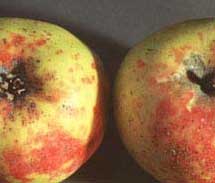 San Jose scale has become more of a problem in
Kentucky due to the loss of several products that had
effectively keep this insect under control in the past.
New EPA restrictions on the use of Penncap-M and
Lorsban have forced apple and peach producers to
find other methods to keep this orchard-threatening
insect from damaging apple, pear, and peach trees. It
is a sucking insect that injects a toxin into the plant as
it feeds causing localized discolorations. The presence
of reddish blemishes on fruit at harvest indicates
potentially damaging numbers on the trees. Left
uncontrolled, San Jose scale can kill the entire tree in
a few years. If such damage is noted, inspect trees for
scale, especially one year-old wood. Purplish-red
halos on young bark are indications of scale
infestation.
San Jose scale has become more of a problem in
Kentucky due to the loss of several products that had
effectively keep this insect under control in the past.
New EPA restrictions on the use of Penncap-M and
Lorsban have forced apple and peach producers to
find other methods to keep this orchard-threatening
insect from damaging apple, pear, and peach trees. It
is a sucking insect that injects a toxin into the plant as
it feeds causing localized discolorations. The presence
of reddish blemishes on fruit at harvest indicates
potentially damaging numbers on the trees. Left
uncontrolled, San Jose scale can kill the entire tree in
a few years. If such damage is noted, inspect trees for
scale, especially one year-old wood. Purplish-red
halos on young bark are indications of scale
infestation.
On apples, a new insect growth regulator, Esteem, is available to control San Jose scale. It can be used to control the nymphs when applied during the late dormant to pink stage, or it can be used to target the crawlers in late May. It is not registered for use on peaches. On peaches, growers in the south have had good control with multiple oil applications. In these areas, growers using two oil sprays during dormant and delayed dormant periods reduced their problems with San Jose scale. When using oils for control, producers need to understand and follow label precautions carefully.
Spray adjuvants are normally thought of as chemical additives, which are not pesticides, that are designed for pesticide applications primarily to enhance pest management, spray operations or environmental safety. Adjuvants include surfactants, supplements, detergents, wetting agents, penetrants, oils, crop oils, petroleum oils, vegetable oils, phytoblands, stickers, film foamers, extenders, spreaders, spreader-stickers, deposit builders, binders, thickening agents, film makers, foams, emulsifiers, dispersants, antiflocculants, stabilizing agents, synergists, sequesterents, safeners, coupling agents, co-solvents, compatibility agents, buffering agents, humectants, antifoam agents, modifiers, and all-purpose spray adjuvants. Many of these terms are used interchangeably. For example, wetting agents and spreaders reduce surface tension of the spray on the target surface while stickers, binders and extenders are adjuvants that allow spray residue to resist wash- off.
It is important to realize that commercial fungicide formulations often contain additives along with the active ingredient to aid in fungicide spread and retention. Some pesticides might serve as adjuvants themselves because, when tank-mixed with a fungicide; they may modify the performance of the spray. For example, when maneb or mancozeb fungicides are added to copper sprays, bacterial spot control from copper is enhanced on tomato and pepper. However, maneb or mancozeb are not considered to be adjuvants commercially because they are used primarily as fungicides.
Not all adjuvants are alike. Growers need to consult the fungicide label and the adjuvant label to determine if their fruit disease management program will be enhanced with an adjuvant. Fruit growers are increasingly using dilute horticultural oils not only late in the dormant season but also during the summer to enhance insect management efforts. Some of these oils can affect the performance of fungicides; indeed some oils are mildly fungitoxic.
Enhancement of protectant fungicides is attained primarily by utilizing those adjuvants that possess spreading (wetting) and sticking properties. The spreader helps to evenly cover as much of the leaf surface as possible with the spray and the sticker helps to maintain the spray residue on the leaf surface for periods of time. There is some uncertainty on whether or not adjuvants enhance systemic fungicide performance. Growers need to be aware that an adjuvant that increases solubility or penetration of fungicides into the plant might cause phytotoxicity. Thus, only use adjuvants recommended on the fungicide label.
Considerations for adjuvant use.
 Most all eastern tent caterpillar (ETC) egg masses have
hatched. The small larvae are constructing silken
platforms at major branches and soon will be
expanding them into recognizable tents as foliage
develops and their feeding increases.
Most all eastern tent caterpillar (ETC) egg masses have
hatched. The small larvae are constructing silken
platforms at major branches and soon will be
expanding them into recognizable tents as foliage
develops and their feeding increases.
While any insecticide applications made should be directed at small larvae, there is plenty of time to assess infestations and identify sites that need to be treated. Dipel or Bt-based insecticides work as stomach poisons so residues on plant foliage must be ingested. This means there should be plenty of open foliage on trees to capture the spray droplets. These products have no contact activity through direct application to caterpillars or as a result of them crawling on treated surfaces.
ETC larvae tend to leave their tents and feed at relatively predictable times during the day - about 6 am and 8 pm. Nearly 80% of their feeding is done during the darkness near dawn and dusk. There is a mid-afternoon spurt of activity but morning and evening activity periods tend to be about twice as long. These feeding times are very synchronized when the caterpillars are small and begin to be come less organized as they get older.
This behavior provides 2 advantages to them: 1) they are active when the risk of being eaten by birds is reduced and 2) they can digest their food and empty their gut in their tents during the warmer part of the day and leave it with an empty stomach when it is time to feed again.
This behavior can be used to advantage in timing an
insecticide application immediately before ETC begin
a major feeding spurt. An afternoon application,
weather permitting, should be an effective strategy
for 2 reasons. 1) ETC larvae spend a lot of time
feeding at dusk and around dawn, so the insecticide
residue will be "fresh". 2) Bt insecticides (DiPel, etc.)
are broken down rapidly by sunlight. This application
time reduces the exposure of the residue to UV light
prior to feeding periods.

 In a recent survey of 674 Kentucky households, 93
percent expressed concern over finding termites in
their homes. The entomology department receives
many calls from people wanting to know what can be
done to protect their largest investment or if a
certain practice or condition is likely to cause termite
problems. Homeowners can reduce the risk of termite
attack by following these suggestions.
In a recent survey of 674 Kentucky households, 93
percent expressed concern over finding termites in
their homes. The entomology department receives
many calls from people wanting to know what can be
done to protect their largest investment or if a
certain practice or condition is likely to cause termite
problems. Homeowners can reduce the risk of termite
attack by following these suggestions.
1. Eliminate wood contact with the ground.
Many
termite infestations result from structural wood being
in direct contact with the soil. Earth-to-wood contact
provides termites with easy access to food, moisture,
and shelter, as well as direct, hidden entry into the
structure. Wood siding, porch steps, latticework, door
or window frames and similar wood items should be
at least six inches above ground level. Eliminating
wood-to-ground contact may require regrading or
pulling soil or mulch back from the foundation,
cutting the bottom off of siding, or supporting steps or
posts on a concrete base. Posts or stairs embedded in
concrete are also vulnerable to termites since they
usually extend all the way through the concrete to the
soil. Wood that has been pressure treated is not
immune to termite attack; termites will enter
pressure-treated wood through cut ends and cracks,
and will also build tunnels over the surface.
2. Don't let moisture accumulate near the foundation.
Termites are attracted to moisture and are more likely
to "zero in" on a structure if the soil next to the
foundation is consistently moist. Water should be
diverted away from the foundation with properly
functioning gutters, down spouts and splash blocks.
Leaking faucets, water pipes and air conditioning
units should be repaired, and the ground next to the
foundation should be graded (sloped) so that surface
water drains away from the building. Homes with
poor drainage may need to have tiles or drains
installed. Lawn sprinklers and irrigation systems
should be adjusted to minimize puddling near the
foundation.
3.Reduce humidity in crawl spaces.
Most building
codes call for 1 square foot of vent opening per 150
square feet of crawlspace area. For crawlspaces
equipped with a polyethylene vapor barrier (see
below), the total vent area often can be reduced to 1
square foot per 300 to 500 square feet of crawl space
area. One vent should be within 3 feet of each exterior
corner of the building. Shrubs, vines and other
vegetation should not be allowed to grow over the
vents since this will inhibit cross-ventilation. Moisture
and humidity in crawl spaces can further be reduced
by installing 4-6 ml polyethylene sheeting over about
75 percent of the soil surface.
4. Never store wood or paper against the foundation
or inside the crawl space.
Firewood, lumber,
cardboard boxes, newspapers, and other cellulose
materials attract termites and provide a convenient
source of food. When stacked against the foundation
they offer a hidden path of entry into the structure
and allow termites to bypass any termiticide soil
barrier that is present. Vines, ivy, and other dense
plant material touching the house should also be
avoided. Where practical, dead stumps and tree roots
around and beneath the building should be removed,
along with old form boards and grade stakes left in
place after the building was constructed.
5. Use mulch sparingly, especially if you already have
termites or other conducive conditions.
Any
cellulose-containing material, including mulch, can
attract termites. Termites are especially attracted to
mulch because of its moisture-retaining properties.
Where mulch is used, it should be applied sparingly
(2-3 inches is usually adequate), and should never be
allowed to contact wood siding or framing of doors or
windows. Since the moisture associated with mulch is
probably as much or more of a termite attractant than
the wood itself, it makes little difference what type of
mulch is used, e.g., cypress, pine bark, etc. Crushed
stone or pea gravel improves drainage and has no
nutritional value to termites, and therefore may be
somewhat less attractive although cosmetically
unappealing to most homeowners. Such materials also
reduce problems with such pests as millipedes,
pillbugs, earwigs and crickets.
6. Consider treatment by a professional pest control
firm.
Buildings have many natural openings through
which termites can enter, most of which are hidden.
While the measures outlined above will help make a
house less attractive to termites, the best way to
prevent infestation is to treat the adjoining soil with a
termiticide. There are two general categories of termite
treatment, liquids and baits. The purpose of a liquid
treatment is to make the ground around the
foundation repellent and/or toxic to termites so that
they will not infest the structure. While most of the
liquid termiticide products are repellent, two newer
materials, Premise® (imidacloprid) and Termidor®
(fipronil), are non-repellent to termites foraging in the
soil. Consequently, termites tunneling into the treated
zone are killed. In Kentucky, Premise and Termidor
are proving somewhat more reliable, in their ability to
alleviate a termite problem in the initial attempt. Baits
can also be installed to eliminate termites foraging in
the vicinity of a structure. See Entfact-644,
Consumer Update: Termite Baits,
and ENT-65,
Termite Baits: A Guide for Homeowners.
Preventively treating a home for termites is a reasonable investment, especially if the structure has no prior history of treatment. If the building was previously treated by a pest control firm, it's a good idea to maintain the service agreement by paying the annual renewal fee. Should termites re-infest the building (which can happen even if the initial treatment was performed correctly), the company will return and retreat the affected area at no additional charge.
Whether or not a person chooses to have their home treated, they should know the signs of termite infestation:

There has been a lot of new chemistry that has been clearing the EPA, and the latest insecticide is a product called Assail. This product, manufactured by Aventis, has received an approved label for use on the leafy vegetables (i.e. lettuce, spinach), cole crops (cabbage, broccoli, cauliflower), fruiting vegetables (eggplant, pepper, tomato), and pome fruits (apple, pear) crop groupings. This product, used as a foliar spray, is labeled to control a wide variety of pests including aphids, whiteflies, plant bugs, Colorado potato beetle, codling moth, leafhoppers, and psylla.
The active ingredient, acetamiprid, is in the neonicotinyl class of insecticides. Some refer to this class as the chloronicotinyls. Other commercial products in this class include imidacloprid (Provado, Admire) and thiamethoxan (Actara, Platinum). The differences between acetamiprid and these other products is that it controls caterpillars, such as codling moth, it is used only as a foliar spray, and it does not move through the plant systemically as with Admire and Platinum.
Assail 70WP is formulated as a 70% wettable powder and bears the signal word "CAUTION," has a 12 hour restricted entry interval, and is a general use pesticide. On the crops listed above, Assail cannot be applied not less than 7 days before harvest.
Reports of mislabeling and faulty distribution of pesticides in some areas of the state have the Kentucky Department of Agriculture's Division of Pesticide Regulation warning retailers to be aware of their responsibilities.
Last year, the division received several reports of the pesticide Actigard being distributed without proper labeling. According to federal regulations mandated by the U.S. Environmental Protection Agency, no pesticide may be distributed without the manufacturer's labeling attached. Photocopying a label is not acceptable.
Product labels contain good information on pesticide distribution. If a label indicates the product is to be sold as a 7.5-ounce box, guidelines do not permit a breaking of the package for selling as 10 individual 0.75-ounce products. Under federal regulations, a retailer who does this becomes liable for the product. If a pesticide is not registered for individual sale, no package can be broken except by the applicator.
For more information, contact the Division of Pesticide Regulation at (502) 564-7274.
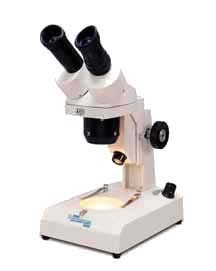
Diseases and other plant problems diagnosed last week included Pythium root rot on coleus, snapdragon and tomato in greenhouses; Botrytis blight on vinca and pepper transplants; black root rot on pansy; dollar spot on bentgrass; Volutella canker on boxwood; Entomosporium leaf spot on photinia; cold injury on barley; and magnesium deficiency and leaf burn (from high evapo-transpiration) on tomato.
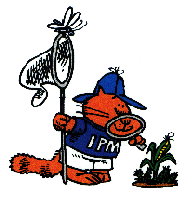
UKREC-Princeton, KY, Mar 29 - Apr 5
| Black Cutworm
| 0
| | |
Lee Townsend
Extension Entomologist